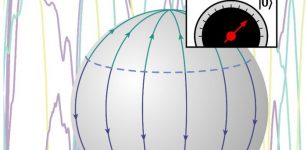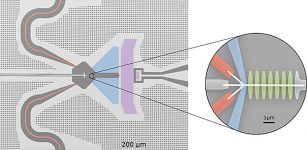Open-Source Software To Speed Up Quantum Research – Developed
Eddie Gonzales Jr. – MessageToEagle.com – Quantum technology is expected to fundamentally change many key areas of society.
Researchers are convinced that there are many more useful quantum properties and applications to explore than those we know today. A team of researchers at Chalmers University of Technology in Sweden has now developed open-source, freely available software that will pave the way for new discoveries in the field and accelerate quantum research significantly.
A team of researchers in Sweden have developed open-source, freely available software that will pave the way for new discoveries and accelerate quantum research significantly. The image shows the local density of current-carrying particles in a mesoscopic vortex lattice in a small mesoscopic superconductor. Credit: Patric Holmwall
Within a few decades, quantum technology is expected to become a key technology in areas such as health, communication, defense and energy. The power and potential of the technology lie in the odd and very special properties of quantum particles.
Of particular interest to researchers in the field are the superconducting properties of quantum particles that give components perfect conductivity with unique magnetic properties. These superconducting properties are considered conventional today and have already paved the way for entirely new technologies used in applications such as magnetic resonance imaging equipment, maglev trains and quantum computer components. However, years of research and development remain before a quantum computer can be expected to solve real computing problems in practice, for example. The research community is convinced that there are many more revolutionary discoveries to be made in quantum technology than those we know today.
Open-source code to explore new superconducting properties
Basic research in quantum materials is the foundation of all quantum technology innovation, from the birth of the transistor in 1947, through the laser in the 1960s to the quantum computers of today. However, experiments on quantum materials are often very resource-intensive to develop and conduct, take many years to prepare and mostly produce results that are difficult to interpret. Now, however, a team of researchers at Chalmers have developed the open-source software SuperConga, which is free for everyone to use, and specifically designed to perform advanced simulations and analyses of quantum components.
The program operates at the mesoscopic level, which means that it can carry out simulations that are capable of “picking up” the strange properties of quantum particles, and also apply them in practice. The open-source code is the first of its kind in the world and is expected to be able to explore completely new superconducting properties and eventually pave the way for quantum computers that can use advanced computing to tackle societal challenges in several areas.
“We are specifically interested in unconventional superconductors, which are an enigma in terms of how they even work and what their properties are. We know that they have some desirable properties that allow quantum information to be protected from interference and fluctuations. Interference is what currently limits us from having a quantum computer that can be used in practice. And this is where basic research into quantum materials is crucial if we are to make any progress,” says Mikael Fogelström, Professor of Theoretical Physics at Chalmers.
These new superconductors continue to be highly enigmatic materials—just as their conventional siblings once were when they were discovered in a laboratory more than a hundred years ago. After that discovery, it would be more than 40 years before researchers could describe them in theory. The Chalmers researchers now hope that their open-source code can contribute to completely new findings and areas of application.
“We want to find out about all the other exciting properties of unconventional superconductors. Our software is powerful, educational and user-friendly, and we hope that it will help generate new understanding and suggest entirely new applications for these unexplored superconductors,” says Patric Holmvall, postdoctoral researcher in condensed matter physics at Uppsala University.
Desire to make life easier for quantum researchers and students
To be able to explore revolutionary new discoveries, tools are needed that can study and utilize the extraordinary quantum properties at the minimal particle level, and can also be scaled up large enough to be used in practice. Researchers need to work at mesoscopic scale. This lies at the interface between the microscopic scale, i.e. the atomic level at which the quantum properties of the particles can still be utilized, and the macroscopic scale which measures everyday objects in our world which, unlike quantum particles, are subject to the laws of classical physics.
On account of the software’s ability to work at this mesoscopic level, the Chalmers researchers now hope to make life easier for researchers and students working with quantum physics.
“Extremely simplified models based on either the microscopic or macroscopic scale are often used at present. This means that they do not manage to identify all the important physics or that they cannot be used in practice. With this free software, we want to make it easier for others to accelerate and improve their quantum research without having to reinvent the wheel every time,” says Tomas Löfwander, Professor of Applied Quantum Physics at Chalmers.
The article, “SuperConga: An open-source framework for mesoscopic superconductivity,” has been published in Applied Physics Reviews and was written by Patric Holmvall, the Department of Physics and Astronomy, Uppsala University, and Niclas Wall Wennerdal, Mikael Håkansson, Pascal Stadler, Oleksii Shevtsov, Tomas Löfwander and Mikael Fogelström, the Department of Microtechnology and Nanoscience at Chalmers University of Technology, Sweden.
SuperConga is open-source software and is free to download.
More on the microscopic, mesoscopic and macroscopic scales
The mesoscopic regime is at the interface between the macroscopic and microscopic regimes. In the macroscopic regime (typically millimeters and larger), classical physics dominates, describing everyday objects such as footballs, cats or perhaps a coffee maker. This contrasts with the microscopic regime, where quantum physics prevails, and much smaller objects can be measured, such as electrons, atoms and other particles.
The odd properties of quantum particles can be explored on this tiny scale—properties that allow them to be in two places at once or to be perfectly conducting. Mesoscopic quantum components (typically micrometers down to nanometers) are so small that the strange properties of quantum particles can be accessed and used, but also large enough that they can be applied in practice. Open-source codes already exist for simulations at either the microscopic or more macroscopic level. SuperConga is the first freely available software in the world capable of simulating superconductors at the mesoscopic level.
Written by Eddie Gonzales Jr. – MessageToEagle.com Staff











